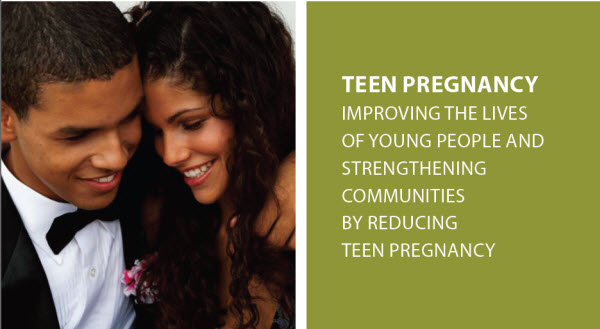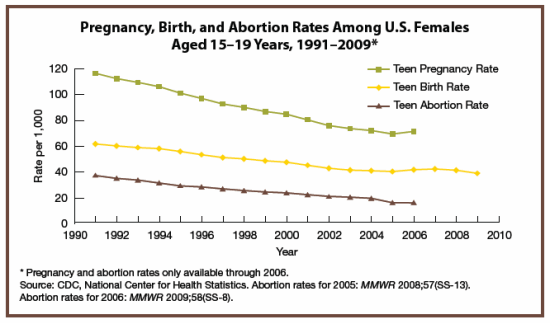Teen Pregnancy
Improving the Lives of Young People and Strengthening Communities by Reducing Teen Pregnancy
At A Glance 2011

On this Page
Teen Pregnancy in the United States
In 2009, a total of 409,840 infants were born to females aged 15–19 years, for a live birth rate of 39.1 per 1,000 females in this age group. Nearly two-thirds of births to females younger than age 18 and more than half of those among females aged 18–19 years are unintended. The U.S. teen birth rate fell by more than one-third from 1991 through 2005, but then increased by 5% over 2 consecutive years. Data for 2008 and 2009 indicate that the long-term downward trend has resumed. Teen pregnancy and birth rates in the United States are substantially higher than those in other Western industrialized nations.
The Adverse Effects of Teen Pregnancy
The social and economic costs of teen pregnancy and childbearing are often high, and these costs can be both immediate and long-term for teen parents and their children. For example, teen pregnancy and childbirth contribute significantly to drop-out rates among high school girls. Only about 50% of teen mothers receive a high school diploma by age 22, compared with nearly 90% of women who did not give birth during adolescence.
Children who are born to teen mothers also experience a wide range of problems. For example, they are more likely to
- Have fewer skills and be less prepared to learn when they enter kindergarten.
- Have behavioral problems and chronic medical conditions.
- Rely more heavily on publicly funded health care.
- Be incarcerated at some time during adolescence.
- Drop out of high school.
- Give birth as a teenager.
- Be unemployed or underemployed as a young adult.
Teen pregnancy and childbirth cost U.S. taxpayers an estimated $9 billion per year because of increased health care and foster care costs, increased incarceration rates among the children of teen parents, and lost tax revenue from teen mothers who earn less money because they have less education.
Preventing Teen Pregnancy
Teen pregnancy prevention is of paramount importance to the health and quality of life of young people and communities throughout the United States. It is also one of CDC's six public health priorities. CDC's efforts in this critical area include promoting evidence-based programs designed to help teenagers develop "protective factors" to avoid teen pregnancy and childbirth. Examples of protective factors include
- Knowledge of sexual health, HIV infection, other sexually transmitted diseases (STDs), and pregnancy (including methods of prevention).
- Perception of HIV risk.
- Personal values about sex and abstinence.
- Attitudes toward condom use.
- Perception of peer norms and behavior about sex.
- Individual ability to refuse sex and to use condoms.
- Intent to abstain from sex or limit the number of partners.
- Communication with parents or other adults about sex, condoms, and contraception.
- Individual ability to avoid risk and risk behaviors associated with HIV and other STDs.
- Avoidance of places and situations that might lead to sex.
- Intent to use a condom.
CDC's Response: Reducing Teen Pregnancy and Promoting Health Equity
As part of President Obama's Teen Pregnancy Prevention Initiative (TPPI), CDC is partnering with the federal Office of the Assistant Secretary for Health (OASH) to reduce teen pregnancy and address disparities in teen pregnancy and childbirth rates. The OASH's Office of Adolescent Health supports public and private groups to fund evidence-based or innovative teen pregnancy prevention programs that are medically accurate and age-appropriate.
TPPI is focused on communities with the highest rates, with an emphasis on reaching African American and Hispanic/Latino youth. To reduce teen pregnancy and childbirth rates, programs will need to use broad strategies designed to reach a majority of youth in a community. They also will need to use more intensive strategies that are tailored to reach youth who are at the highest risk.
The goals of the TPPI are to
-
Reduce the rates of teen pregnancy and childbirth in priority populations.
-
Increase the number of youth who have access to evidence-based or evidence-informed programs designed to prevent teen pregnancy.
-
Increase links between teen pregnancy prevention programs and community-based clinical services.
-
Educate stakeholders about evidence-based or evidence-informed strategies designed to reduce teen pregnancy and about the needs and resources of the priority communities.
Organizations funded through this partnership will address all of these goals.
In 2010, CDC provided 5-year funding for two types of cooperative agreements to address teen pregnancy. The first is a joint CDC and OASH project that provides up to $10 million from the TPPI to support demonstration projects conducted by community-based organizations. These projects will test innovative, sustainable, and multicomponent initiatives in communities. CDC will provide another $2 million to national partners to provide training and technical assistance for these projects. CDC also funded a cooperative agreement to support a Title X family planning program grantee, the Alabama Department of Public Health, to expand its teen pregnancy prevention programs.
Project Partners Funded for 2010–2015
National Partners
- Advocates for Youth
- Cicatelli Associates, Inc.
- Healthy Teen Network
- John Snow, Inc. and JSI Research & Training Institute, Inc.
- National Campaign to Prevent Teen and Unplanned Pregnancy
Title X Partner
- Alabama Department of Public Health
State and Community Partners
- Adolescent Pregnancy Prevention Campaign of North Carolina
- City of Hartford Department of Health and Human Services, Connecticut
- Family Planning Council, Southeastern Pennsylvania
- Fund for Public Health in New York, Inc.
- Georgia Campaign for Adolescent Pregnancy Prevention
- Massachusetts Alliance on Teen Pregnancy
- South Carolina Campaign to Prevent Teen Pregnancy
- University of Texas Health Science Center at San Antonio
Identifying Youth at Higher Risk
The highest rates of teen pregnancy and childbirth are among non-Hispanic blacks, Hispanics/Latinos, and American Indians/Alaska Natives. Rates also are high among youth of all races and ethnicities who are socioeconomically disadvantaged. In 2009, 57% of teen births were to African American and Hispanic youth, although they represent only 35% of the total population of females aged 15–19 years. CDC is focusing on these priority populations in order to improve the lives of adolescents who are affected by health disparities, as well as to reduce overall teen childbirth rates in the United States. CDC also is working to help all youth who are at risk, such as those in foster care and the juvenile justice system.
Past Programs Have Shown Success
During 2005–2010, CDC funded several organizations through its Promoting Science-Based Approaches to Prevent Teen Pregnancy program. Funded organizations included nine state organizations, four Title X Regional Training Centers, and three national teen pregnancy prevention organizations. CDC provided state and local organizations with intensive training and technical assistance to help build their capacity to develop evidence-based prevention programs. CDC also helped these organizations evaluate and sustain their efforts. Youth in school and community settings received comprehensive sex education curricula or youth development programs that have been shown to prevent teen pregnancy or reduce associated behavioral risk factors. For example,
-
In 2007, Washington State enacted the Healthy Youth Act. This law requires that all public schools follow the Washington State Department of Health's 2005 guidelines for sex education, which include information about contraception and abstinence.
-
In 2009, Washington State enacted the Proven Programs Act, which requires that any funding the state seeks for sex education must be for programs that are effective, medically accurate, and proven to work.
-
In 2007, Colorado enacted a law requiring that schools that offer sex education develop scientifically and medically accurate curricula that stress abstinence and discuss the health benefits of using contraception.
-
In 2009, North Carolina enacted a law requiring that all students in grades 7–9 receive comprehensive sex education unless their parents object.
Success Stories
North Carolina: Healthy Youth Act Helps Prevent Teen Pregnancy Across the State
The Adolescent Pregnancy Prevention Campaign of North Carolina (APPCNC) helps communities prevent teen pregnancy through advocacy, collaboration, and education. The overall goal is to increase the number of effective prevention programs available to North Carolina youth through local partners.
The APPCNC's efforts included taking a leadership position on a state task force set up to guide the use of evidence-based programs and medically accurate reproductive health and safety education in North Carolina's school health programs. As a result of the APPCNC's efforts, state legislators passed the Healthy Youth Act of 2009, which took effect in 2010.
To achieve its goal of ensuring that more young people in North Carolina have access to effective teen pregnancy prevention programs, the APPCNC
-
Brought together a coalition of stakeholders and helped choose the name for the Healthy Youth Act. It also created a youth leadership council whose members worked with state legislators and mobilized parents and youth to support sex education reform.
-
Provided information and education to state legislators on a regular basis.
-
Organized Adolescent Health Advocacy Day, during which more than 200 teenagers attended the first hearing on the Healthy Youth Act before the legislature's health committee.
-
Helped set up an educational session that brought together national leaders in teen pregnancy prevention and state legislators.
-
Organized more than 300 meetings between state legislators and community and youth leaders.
-
Provided evidence-based curricula materials to state legislators who supported the Healthy Youth Act to use as examples of effective programs.
Massachusetts: Reaching Youth at Risk Through Multiple Programs
The Massachusetts Alliance on Teen Pregnancy (the Alliance) strives to prevent teen pregnancy and empower youth to make healthy decisions. To support these efforts, the Alliance gives educators, health care workers, and other professionals who work with youth the technical assistance and training they need to implement evidence-based prevention programs.
The Alliance has worked with community groups, family planning clinics, and schools in communities that have teen childbirth rates 2–4 times higher than the state's average. With the Alliance's guidance, strong local partnerships have been established to reach Massachusetts' most vulnerable youth with prevention programs that work. These local partners serve mainly African American and Hispanic/Latino youth who have the greatest need for programs that are designed to prevent teen pregnancy and services that promote health.
As a result of the Alliance's work, more than 7,000 youth are being served by evidence-based or evidence-informed teen pregnancy prevention programs. The Alliance helps its partners implement and evaluate these programs, and it supports new community initiatives.
Examples of these efforts include the following:
-
In Springfield, the Family Life and Sexual Health (F.L.A.S.H.) curriculum is now provided in every public middle school and high school in the city, reaching nearly 3,800 students. The mayor set up a special advisory board called the Springfield Adolescent Sexual Health Advisory to find ways to reduce teen pregnancy. The board made it a priority to support community-wide efforts to address this public health problem.
-
In the city of Holyoke, all ninth graders in the Holyoke School District will receive the F.L.A.S.H. curriculum, as well as the ¡Cuidate! curriculum, which is designed to reduce sexual risk behavior related to HIV infection among Hispanic/Latino youth. To make the program a reality, the Alliance helped get support from a key district administrator.
-
In Framingham, the Making Proud Choices curriculum is now available in every eighth grade class in the city's public school system, reaching nearly 600 students. This curriculum strives to prevent pregnancy, sexually transmitted diseases (STDs), and HIV infection among adolescents aged 11–13 years by empowering them to change their behaviors in ways that will reduce their risk.
-
More than 80% of the student body of the Phoenix Charter Academy in Chelsea is made up of underserved African American and Hispanic/Latino youth. Each year, the school uses the ¡Cuidate! and Power Through Choices curricula to reach 25–49 students aged 13–18 years who are at higher risk for teen pregnancy. Power Through Choices is designed specifically for young people living in the foster care system.
-
About 1,800 ninth and tenth graders in the Lowell School District are receiving the F.L.A.S.H. and Safer Choices curricula. Safer Choices is a multicomponent intervention that is designed to prevent HIV infection, other STDs, and unintended pregnancy among participating students.
Pennsylvania: Teen Pregnancy Programs Designed to Reach Youth at Risk
Racial and ethnic disparities in teen pregnancy and birth rates are larger in Pennsylvania than they are nationally. To address this problem, the Pennsylvania Coalition to Prevent Teen Pregnancy (PCPTP) supports local communities and school districts to develop strategies to implement and sustain effective teen pregnancy prevention programs. This support includes technical assistance, training, resources, and statewide leadership.
The PCPTP focuses its efforts in areas of the state with the highest teen pregnancy, birth, and poverty rates. The coalition helps community groups identify specific risk behaviors among the youth they serve and choose age-appropriate curricula to address these behaviors. As a result of the PCPTP's efforts, evidence-based teen pregnancy prevention programs now reach 6,700 students in school districts across the state, including those in Harrisburg, Lancaster, Reading, Erie, Pittsburgh, Union City, and York City.
Results from an evaluation of one school district's program found that students who participated in a teen pregnancy prevention class showed significant improvements in knowledge, skills, attitudes, and intentions related to preventing pregnancy and STDs. For example,
-
Before the class, 79% of students agreed with the following statement: "Not having sex is the best way to avoid getting HIV or an STD." After the class, 89% agreed with this statement.
-
Before the class, 81% of students correctly answered the question, "Can a person have an STD and not know it?" After the class, 94% answered this question correctly.
-
Before the class, only 46% of students correctly answered the question, "Can wearing a condom keep you from getting an STD or HIV?" After the class, 80% answered this question correctly.
-
Before the class, 86% of students agreed with the following statement: "It is important to me that I not get an STD." After the class, 94% agreed with this statement.
-
Before the class, 80% of students agreed with the following statement: "I am not ready to be a parent." After the class, 91% agreed with this statement.
For more
information please contact the
Centers for Disease Control and Prevention
National Center for Chronic Disease Prevention and Health Promotion
4770 Buford Highway NE, Mail Stop K-20, Atlanta, GA 30341-3717
Telephone: 800-CDC-INFO (232-4636) • TTY: 888-232-6348
E-mail:
cdcinfo@cdc.gov • Web: http://www.cdc.gov/teenpregnancy
Contact Us:
- Centers for Disease Control and Prevention
National Center for Chronic Disease Prevention and Health Promotion (NCCDPHP)
4770 Buford Hwy, NE
MS K-40
Atlanta, GA 30341-3717 - 800-CDC-INFO
(800-232-4636)
TTY: (888) 232-6348
8am-8pm ET
Monday-Friday
Closed Holidays - Contact NCCDPHP






